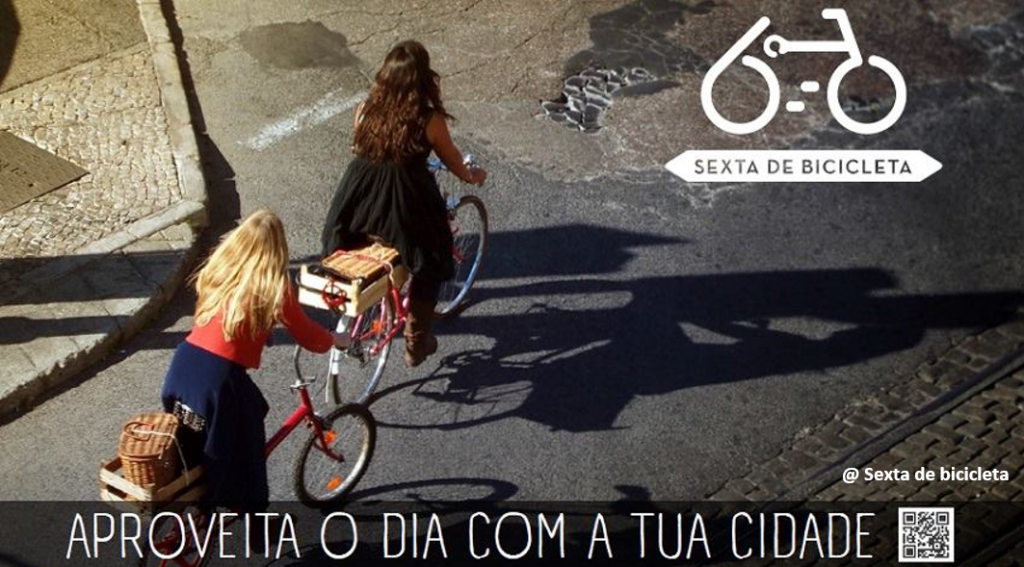

1. Presentation
Organization mobility management is a set of measures taken by companies and organizations that aim to promote cycling among their employees. At its core is the creation of a sustainable mobility plan for the organization. It should be a comprehensive plan that takes into account the different types of travel involved and provides the required support and facilities so that they are carried out in a sustainable manner. In the case of cycling, the plan may include information campaigns, creation of infrastructure to support bicycle users and promotion of incentives, among others (see list of mobility management measures for organizations).
2. Objectives
- Combating stress and sedentary lifestyles that increasingly hit the active population, with repercussions on their productivity and absenteeism;
- Reducing traffic congestion and pollution in cities, making urban mobility more efficient and space more attractive;
- Improving workers’ quality of life.
3. Measure’s importance
Commuting trips are the main creators of road congestion and pollution. By involving the working population, it is possible to promote sustainable mobility within a large and varied group of society. As such, the message is more easily disseminated, discouraging more polluting modes of transport and reducing the number of trips by motor vehicle, in some cases sharing trips, and encouraging the use of less polluting modes to a wider population.
In addition, bicycle reduces stress and anxiety, promoting healthier, happier and more productive employees.
1. Good Practices
– Explain the principles behind the measures taken so that their need and functioning are clear (See Information).
– Cycling promotion campaigns and events, such as “Bike to Work”, are great ways to promote the benefits and encourage cycling (See Bike events). Other measures such as carpooling can also be effective, especially in large companies or organizations. (See list of mobility management measures for organizations)
– Engage the employees in programme implementation. Consulting those who already put into practice the measures to be implemented can provide good insight into the advantages to be promoted and the disadvantages to be solved.
– Monitor employees’ adaptation to changes and reformulate measures to respond to users’ needs, without compromising sustainable ideals (See Management, monitoring and maintenance).
– Make sure cycling infrastructures exist before discouraging the car.
– In cases where there is a need to improve urban infrastructure, it will be useful to collaborate with the government departments required to implement a project for cycling infrastructure (See Cycling network and Safe and efficient intersections).
– Public authorities may also implement cycle-friendly employer incentives and certification schemes (learn more).
– Ensure the safety, comfort and accessibility of cycling infrastructures. Planning of cycle paths, parking lots and changing rooms should take into account certain conditions such as a comfortable pavement, visible signage, efficient lighting, accessible parking and the safety of parked bicycles and the users’ belongings (such as in changing rooms).
2. Actions
 | Organization mobility plan The mobility plan is a tool often used to implement the various mobility management measures of the organization in an integrated and systematic way. It is a package of measures tailored to the specific needs of each organization and aims to promote more sustainable transport choices and reduce car dependency. This plan may include: information and awareness campaigns; provision of changing rooms and showers; bike parking; establishing groups of cyclists; providing bicycles for occasional use; offering financial incentives and subsidies per kilometre travelled; promoting and publicizing cycling; collaboration between municipality and companies/ organizations to identify the potential for improvement of their cycling accessibility; repair services, etc. (See list of mobility management measures for organizations). |
 | Bike to Work Campaigns “Bike to work” day/week/month is a well-known and disseminated campaign, or event. Usually, it includes challenges and incentives to make people travel by bicycle to work more frequently, or to try and travel by bike for the first time. It can include provision of breakfast, contests, useful tokens, bicycle activities and other incentives. Note: Is necessary to designate some employees to plan, organize and manage the programme; in some cases, it can be the organization itself to provide the bicycles. Learn More: Bike commuter challenge; European project Bike2Work, promoted by the ECF (European Cyclists' Federation). |
 | Car pooling Promote and coordinate car sharing among employees who take the same routes, sharing the trip cost with each other. Promotion campaigns and benefits should be offered, such as reserving parking spaces for car-poolers, offering an annual car maintenance services or monthly cleaning. It is also possible to implement a database to facilitate contact between employees. Advantages: Reduce employees’ financial expenses. Disadvantages: May promote the use of private car. |

Like casual Fridays, Bicycle Fridays are an initiative promoted by various employers around the world to foster active and sustainable mobility and worker co-operation, where everyone is challenged to use the bicycle as a means of transport on Fridays. Cycling to work once a week can be the trigger for a bigger change. In Portugal, the association Mubi also promotes this initiative to which everyone can join.
Learn more: sextadebicicleta.mubi.pt/
1. Impacts
 | Mobility system efficiency By discouraging the use of car by workers in organizations and companies and by promoting cycling and public transport, the need for private parking decreases, as well as traffic congestion, and, consequently, efficiency in the mobility system is improved. |
 | Livable streets By reducing traffic in urban areas, the streets become more appealing. n the surroundings of organizations and companies, the space available for private parking may be allocated to other leisure functions. |
 | Protection of the environment Fewer motorized trips result in reduced pollution and improvement of the environment. |
 | Inclusion, equity and accessibility Raising the statute and removing the stigma of cycling increases the range of transportation possibilities for all. If the example of its use is given by someone with an important position in the hierarchy of the organization or company (a factory director or a university professor), it can have a decisive impact on change. It is also necessary to respond to the needs of people with disabilities. |
 | Safety and comfort Measures taken within organization mobility management plans targeting cycling must be accompanied by safe and comfortable infrastructure. In the case of carpooling, platforms are safer when they involve trusted users, that is, when they have a common bond to the organization. |
 | Economic value Sustainable mobility measures reduce the workers and employers expenses (in transport and health care), increasing the available income. |
 | Awareness and acceptability The workplace has a significant impact on cycling or other mobility options. Employer support, peer cycling, and mutual encouragement promote the perception of cycling as socially accepted or 'normal', positively influencing the choice to commute by bicycle. |
Legend:
| Very positive | Positive | Neutral | Negative | Very negative |
2. Barriers
 | Legal There are no significant barriers. Carpooling systems can pose security and data protection challenges. |
 | Finance In some cases, public authorities and public transport companies partner with organizations that want to implement a mobility plan, but some funds will need to be invested. |
 | Governance The collaboration between public authorities and organizations promoting this measure may raise some barriers in terms of different views and objectives. |
 | Political acceptability No barriers. |
 | Public acceptability The implementation of measures that include restrictions to the car may not be well accepted if they are not preceded by a comprehensive and accessible information campaign, or if the supporting infrastructure needed for the shift from the car to more sustainable transport modes is not implemented. Behavioural change by organization leaders can facilitate acceptance of the measures. |
 | Technical feasibility Organizations, by themselves, may not have the skills to develop the mobility plans and may need to hire specialized staff. |
Legend:
| No barrier | Minimum barrier | Moderate barrier | Significant barrier |
3. Budget
| Area | Measure | Unit | Cost | Implementation year |
| Manchester Metropolitan Area (U.K.) | Subsidies for companies to finance CCTV security, lockers, drying rooms and bicycle hanging racks. | 84 companies and 1 228 bike parking spots. | 0,75 million £ (average of de 6 000£ per company, with a limit of 10 000£* | Data from a 2017 study |
| Birmingham Metropolitan Area (U.K.) | Subsidies for companies to finance bike shelters, hanging racks, showers, hair driers, lockers, drying rooms, CCTV security, repair spots, bicycles and safety equipment for work trips, tool kits and air pump stations. | 27 work places | 0,20 million £ (average of 7 000£ per company, with a limit of 10 000)* | Data from a 2017 study |
* Staff needed to provide some of the funding. In the Birmingham case it was not essential and payment could be replaced by working hours.
Case study 1: Novartis, Basel (Switzerland)

Novartis promotes cycling among its employees by providing a free bike sharing system, creating support infrastructures (changing rooms, sheltered bike parks, etc.) and collaborating with local authorities to implement a network of bicycle paths that connects the different offices of the company. In addition, it regularly conducts information and awareness campaigns.
Impact:
 | Mobility system efficiency The provision of cycling conditions promotes a modal shift from the car to the bicycle, reducing motorized traffic around the company’s premises. |
 | Livable streets By reducing the number of drivers, automobile congestion is reduced and the streets around the company become more attractive, with potential positive impacts for the whole city. |
 | Protection of the environment The modal shift among the company’s employees promotes the protection of the environment. |
 | Inclusion, equity and accessibility No data. |
 | Safety and comfort By creating the right infrastructure to support cycling, the company ensured the comfort and safety of its employees shifting to cycling. |
 | Economic value No data. |
 | Awareness and acceptability The frequent campaigns of bike promotion foster awareness and normalization of the bicycle. At the same time, the creation of support infrastructures reduces some of existing resistance. |
Case study 2: Mobility Plan of Lisbon’s municipal building, Campo Grande 25/27 (Portugal)

In 2008, Lisbon City Council implemented a mobility plan associated with a more comprehensive approach to energy efficiency. The plan comprised a reduction in the number of trips through the implementation of new communication technologies and the promotion of car-pooling, including the creation of an online platform to facilitate contact between employees, the reservation of parking spaces for car poolers and a fuel discount voucher for anyone joining the programme. In addition, the implementation of a real-time information system on public transport has also been established to promote its use.
Impact:
 | Mobility system efficiency By reducing traffic congestion and promoting public transport, the mobility system efficiency is improved, even if focused on a single building. |
 | Livable streets By reducing the number of drivers, automobile congestion is reduced and the streets around the municipal building become more attractive, with potential positive impacts for the whole city. |
 | Protection of the environment By reducing the number of drivers, the protection of the environment is promoted. |
 | Inclusion, equity and accessibility The promotion of carpooling encourages greater inclusion and reinforcement of ties among employees. |
 | Safety and comfort No data. |
 | Economic value The promotion of carpooling and the provision of financial incentives reduces employees’ spending, which may be transferred to other sectors of the economy. |
 | Awareness and acceptability Promoting shared forms of mobility and contact between employees tends to raise awareness on the need for more sustainable choices and their normalization. |
Legend:
| Very positive | Positive | Neutral | Negative | Very negative |
Bike2Work (2019). Bike2Work: smart choice for commuting. Accessed 9 July 2019. Available at: www.bike2work-project.eu
IMT. (2011). Guia para a elaboração de planos de mobilidade de empresas e pólos (Geradores e Atractores de Deslocações). Accessed 14 June 2019. Available at: www.imt-ip.pt/sites/IMTT/Portugues/Planeamento/DocumentosdeReferencia/PacotedaMobilidade/Paginas/QuadrodeReferenciaparaPlanosdeMobilidadeAcessibilidadeeTransportes.aspx
Novartis. (2017). Zagster Bike Share. Accessed 14 June 2019. Available at: http://bike.zagster.com/novartis/
Taylor, I. & Hiblin, B. (2017). Typical Costs of Cycling Interventions: Interim analysis of Cycle City Ambition schemes. Accessed 2 July 2019. Available at: http://www.transportforqualityoflife.com/policyresearch/cyclingandwalking/
